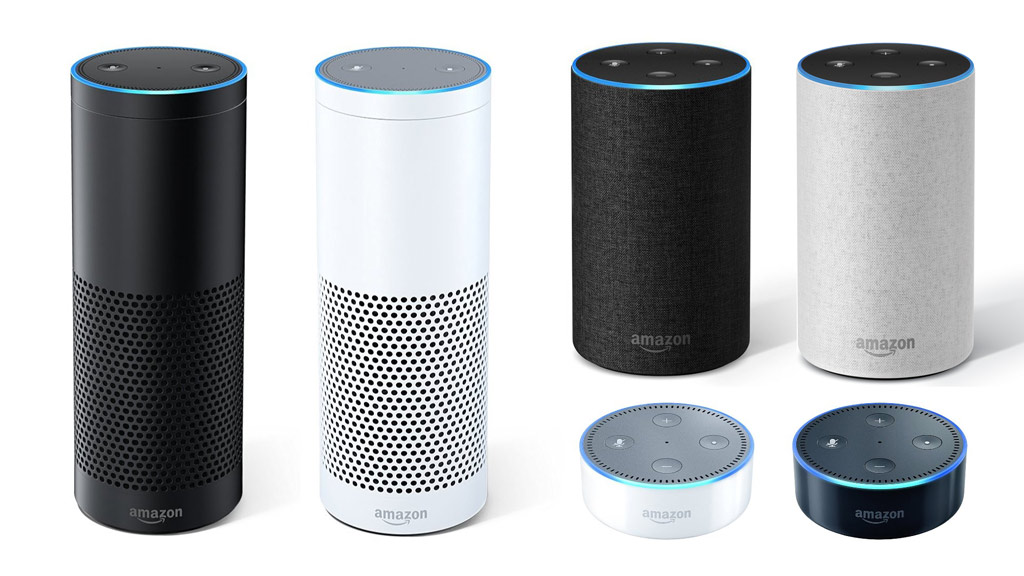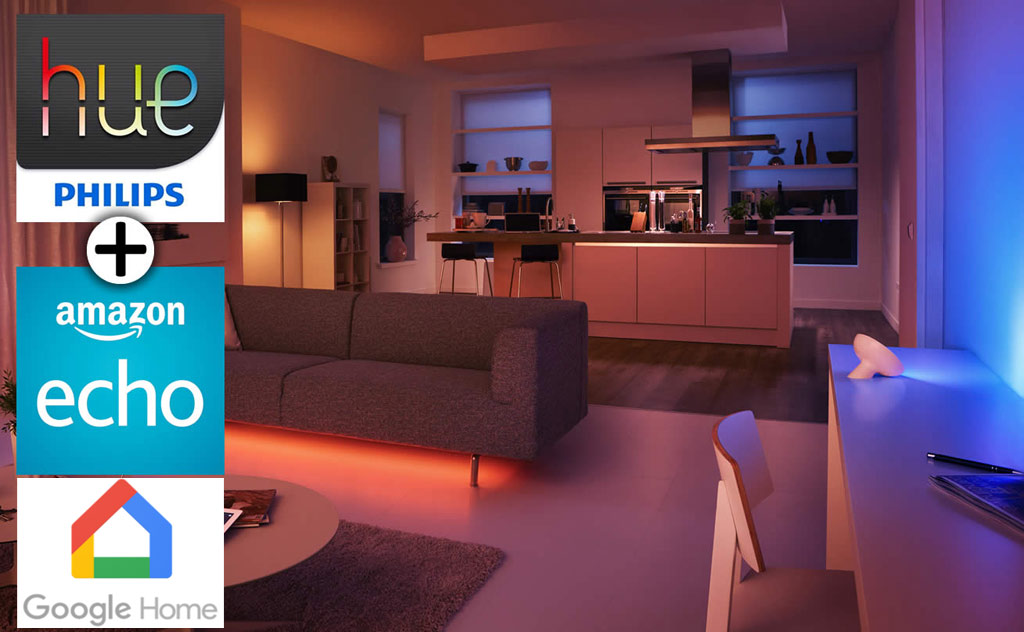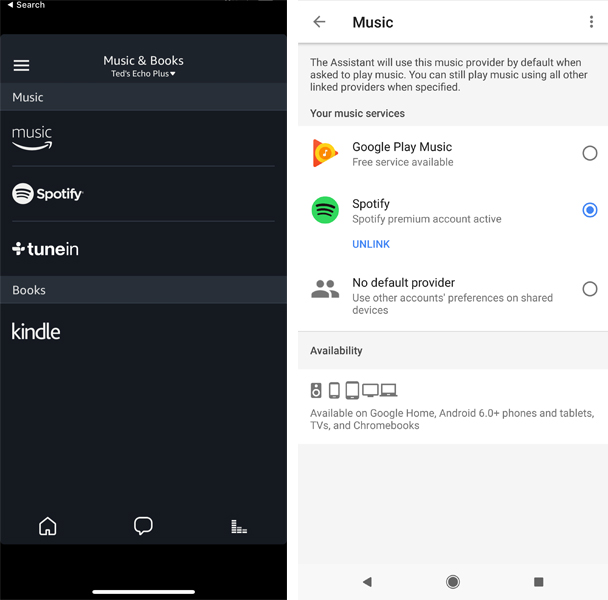
Both Google Home and Amazon Alexa are voice assistants you can utilize in a number of different ways, but they do differ in some distinct ways.
Google and Amazon launched their respective voice platforms in Canada this year, yet they had already been available in other markets some time before. Amazon had the head start, launching Alexa back in 2014, whereas Google launched Home in the fall of 2016.
The basis for both is the same: say a command or ask a question, and the voice assistant responds. You could ask about something specific to your location, or about a person, place or thing. You can integrate compatible smart home devices and control those by voice too. Features abound the more you experiment and dig into them.
While designed to essentially do the same thing, there are some strengths and weaknesses to consider.

Hardware products
Google Home is available on two products thus far—the regular Google Home and the Home Mini. The primary difference between those two is that the regular model has a bigger speaker. Otherwise, they pretty much function the same way, including far field microphones capable of hearing you from across a room.
Alexa is available on three products from Amazon—the Echo, Echo Plus and Echo Dot. They, too, have far field microphones to listen from distance. The Echo and Echo Plus have the same speaker, more or less, though the Plus is much taller and has a built-in Zigbee hub allowing it to connect to compatible smart home products without needing a hub or bridge.

The Echo Dot is like the Google Home Mini. It’s puck-shaped, and small enough to place almost anywhere.
There are two third-party speakers currently available that also integrate Alexa. The Ultimate Ears MegaBlast is one, with the Sonos One being the other. One caveat, however, is that Sonos won’t unlock the Alexa integration until early 2018. Incidentally, the Sonos One may be the first speaker that will integrate both Alexa and Google Home, the latter of which will happen sometime after Alexa starts working.
Connectivity
 With either platform, you need a Wi-Fi connection at home to get these devices to work. And, naturally, they need to be close enough to a power outlet. They are also easy to set up. Just download the Google Home or Alexa apps on your iOS or Android phone, and follow the steps.
With either platform, you need a Wi-Fi connection at home to get these devices to work. And, naturally, they need to be close enough to a power outlet. They are also easy to set up. Just download the Google Home or Alexa apps on your iOS or Android phone, and follow the steps.
Google Home supports casting devices, like the Chromecast and Chromecast Audio. So, for example, plug a Chromecast Audio into the Aux-In port of any speaker, and add it under the Devices section in the app. If the speaker has casting built-in, there’s no need to buy a Chromecast Audio.
For Chromecast sticks you plug into TVs, Google Home can recognize those too. This allows you to play video content or music through the TV by voice. It even works with Netflix, only it can’t dig down to a specific episode or season of a show. Name the show and it will start playing from the beginning or where you left off. With YouTube, you can have more flexibility to search for what you want.
Neither the regular Home nor Home Mini support Bluetooth transmission, meaning you can’t pair it with another speaker to route audio there. You can do it the other way, so that audio from your phone or tablet streams through the Home’s speaker.
The Echo devices are considerably more flexible in that regard. All three support Bluetooth streaming, letting you pair them with other speakers, if you want. They also have Aux-In ports in the back to plug in another speaker with a cable. Google didn’t include Aux-In ports for either one of its speakers.
It’s true that Echo speakers won’t recognize casting devices, so it won’t know what a Chromecast Audio is. I would argue that’s negated by the ability to connect another speaker through wired or wireless means.
Of them all, the Echo Dot is the most attractive for such a purpose. Its tinny speaker isn’t conducive to sustained audio playback, so plugging it into something much bigger can make a huge difference.

What you can say
For Google Home, saying “Hey, Google,” “Ok, Google,” or “Hi, Google,” is necessary to wake it up and listen for a command. You know it’s active when the lights at the top start flashing.
For Alexa, starting your query with, “Alexa,” is required to have it wake up. You can change that, but Echo, Amazon and Computer are your only other options.
In both cases, the platforms will know your name, though they seem to do better with Anglicized names. Still, ask what your name is, and see what happens.
Listing what you can say would be too long for this article, but you can always inquire with either unit. Start off with, “What can I say?” and you will get a quick rundown. It’s not the same each time you ask, either, letting you get some feedback on more phrases. Each app will also list some of the things you can do, adding another resource to peruse when looking to expand further.
Much of the interaction centres on people, places, things and devices. Ask about something location-specific, like weather, traffic or what time a certain business closes for the day.
Think of it like doing a search online. How would you ask in that instance? Apply that to either of these platforms, and they should respond in kind. The key is that phrasing matters because they may not understand what you mean.
Google Home is more conversational in that respect, with a voice that’s a little less monotone. Plus, you can string two commands together at once. Saying, “Hey Google, play Drake on Spotify and set volume to seven,” would do both those things. Alexa can’t handle multiple commands in one phrase, forcing you to do them one at a time.

Smart home integration
Alexa has a distinct advantage here because of the depth of its “Skills” section. Simply put, it integrates with a dizzying array of smart home devices. From smart bulbs, smart locks, smart thermostats, security cameras and even Wi-Fi-enabled iRobot Roomba vacuums, the possibilities are pretty extensive.
The Alexa app has a “Discover” feature that scans for smart home devices in the home. When it finds them, it then makes it easy to link your account for each device or service and then control them through voice.
In contrast, Google Home supports a much shorter list of smart home devices and services. Some key ones are in there, like Philips Hue, Nest, Ecobee, Honeywell, LiFX, Nanoleaf, Netatmo, Wink and Belkin WeMo. Alexa does support all of those too, so Google doesn’t hold much in the way of any exclusivity in that regard.
In addition, Alexa tends to be further evolved when it comes to how deep the integration goes. For instance, Home could change the colour of your Hue lights, but can’t turn on scenes, like Alexa can. These sorts of restrictive smart home controls aren’t uncommon for the Home, and while they could be fixed in future updates, Google has some work to do to close the gap.

Music and audio integration
Spotify Premium subscribers are in the best position for this part because both platforms support the music streaming service with aplomb. Ask for any song, artist, album, genre, mood, or playlist, and they oblige by starting the tunes. The Spotify app has an added advantage in that Alexa and Home-enabled speakers appear in the bottom device playback list.
Google also included support for its own Play Music service, with even the free tier working well. Ask for an artist or genre, and it will start playing. As a paid subscriber, you can hone in much more to your own playlists, artists and songs. Alexa can’t access anything on Play Music.
Radio stations and podcasts also work well for both. Alexa can pull whatever is available from TuneIn, while Home can do the same with Google Play Music, but can’t pull in podcasts from TuneIn.
If you are a serial podcast listener, I would recommend enabling AnyPod as a skill on the Alexa app. Reason being that Alexa can only access the latest episode of a podcast series. AnyPod dives deeper, letting you subscribe and better select the episode you want to hear. I haven’t found a similar solution for Google Home.
If you subscribe to Apple Music, you won’t be able to access anything from that streaming service. The same goes for music files downloaded and stored on your phone. Alexa and Home can’t see them, so your only alternative is to use Bluetooth or casting to wirelessly stream them over to those speakers. From there, you can control playback, like pause, skip or repeat, but not which song to play.
If you like ambient noise, both support that by voice. Amazon has countless available as skills you can add, like fireplace, waterfall, white noise, wind, thunderstorms, and on and on. Google has plenty as well, but it usually leans on Spotify to provide them, so if you aren’t a subscriber, your options may be limited.
Lastly, Echo devices can read Audible and Kindle audiobooks, so you can listen to a reading while relaxing or doing something else. In addition, the Echos can make phone calls, letting you reach out to contacts or dial numbers and talk from across the room.
Google Home can also do phone calls, except contacts need to be in your Google contact list. Or, you can simply call a business or dial a number. Home can’t natively read aloud books, and can’t access any Kindle titles, but you could theoretically start it on your phone and then use the casting button on your Android device (pull down the notification pane) to stream it over.
Getting things done
When it comes to the basics, these two are on the same page. Set an alarm to wake up, or a timer to stay on track with a task. Set a reminder to anything you need to remember, or create a to-do or shopping list by voice. Both will keep track of everything.
Google Home has a built-in broadcasting feature allowing one to wirelessly broadcast to all others. For example, if dinner is ready in the kitchen, tell the Home unit in there to broadcast a message to the unit downstairs where the family is, letting them know.
Alexa has a similar intercom feature, where you can tell one Echo to call another, subsequently relaying whatever message you want to send. This works best when each speaker has a different name, so as to avoid confusing responses.
Either unit can be very helpful in a variety of household situations. Solving a friendly dispute over a particular fact or figure is one, but you can go further. Alexa can access recipes and help guide you along. You just need to add a relevant skill, like Allrecipes, for instance. Access its thousands of recipes on demand. Home is also an effective tool for cooking, with easy to follow instructions.
Since Home has the breadth of Google’s search engine at its disposal, searching for answers is pretty easy. Alexa essentially draws from the same data pool, so you may find similarities here. Wikipedia is widely used for brief summaries on people, places, things and historical events.
Not sure what a word means? Need to know what 12% of 1,555 is? Want to convert currency? Which teams are playing tonight in a certain league? Recite a famous quote from a popular figure? Not sure what song is playing? Just ask Alexa or Home.
Getting comfortable
Some Easter eggs and other components have been included to try and make both platforms relatable and conversational. You can ask either one to tell a joke, flip a coin, or otherwise say something interesting. Trivia games and other interactive elements are in there too. Here’s what Home can do, and here’s what Alexa can do.
Both platforms are ‘works in progress,’ meaning they are designed to continue getting better. They aren’t finished products in that the software running their respective voice platforms will get updated regularly. That should lead to new features down the line to enhance what’s already available.
The Amazon Echo, Echo Dot and Echo Plus are available now. You can also check out the Sonos One and Ultimate Ears MegaBlast.
The Google Home and Google Home Mini are also available now.




Both platforms are ‘works in progress,’ meaning they are designed to continue getting better. They aren’t finished products in that the software running their respective voice platforms will get updated regularly. That should lead to new features down the line to enhance what’s already available. Good post.
Comments are closed.